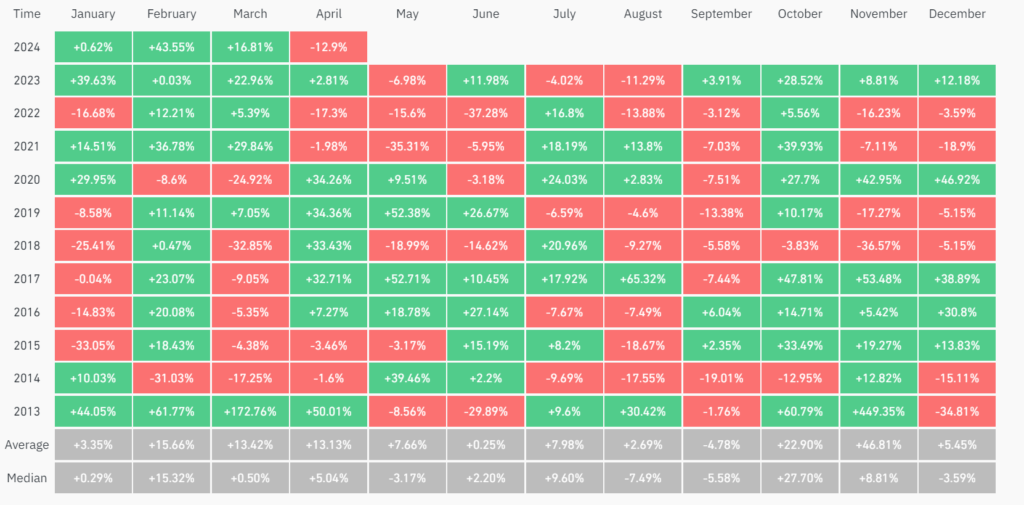Bitcoin is on track to lose 12% in April, starting the month at 71,300 and currently trading at 63000. This marks the end of a seven-month winning streak for the cryptocurrency, which has seen the price surge from 25,900 at the start of September to 71,300 at the start of April.

What has caused the selloff in April?
A combination of factors has hurt the Bitcoin bull run this month.
- The market has reined in expectations for the Fed rate cuts. Sticky US inflation has supported the view that the Fed will keep interest rates high for longer. The prospect of higher rates has lifted the USD and hit demand for riskier assets.
- A broad risk-off mood across the financial market. Riskier assets across the board have struggled this month. The S&P 500 is set to drop 2.6% in April, snapping a 5-month winning run. Meanwhile, the Nasdaq is set to fall 2.4% this month after rallying 25% in just five months.
- Reduced demand for spot Bitcoin ETFs has also pulled on the Bitcoin price this month. Since their launch in January, BTC ETFs have been a key driver of Bitcoin’s price movement. Net inflow days have pushed up the Bitcoin price and vice versa. However, more recently, the group of 11 BTC ETFs has experienced net outflows. Data from SosoValue showed that on April 29, the group of 11 ETFs experienced $51 million in net outflows.
Bitcoin’s near-term outlook
The near-term outlook for Bitcoin could remain challenging. Tomorrow’s Federal Reserve rate decision and Friday’s non-farm payroll report could set the risk tone for the markets for the coming weeks. A hawkish-sounding Fed that pushes back rate cut expectations combined with a strong US jobs report could raise concerns over the Fed cutting rates this year and continue to weigh on risk assets.
Bitcoin seasonality

It’s also worth considering seasonality. May is typically a weak month for Bitcoin. BTC/USD has fallen in May over the past three years. According to Coinglass data, Bitcoin’s price has risen in 5 of the past 11 years and fallen in 6 of the past 11 years. While this tips the balance towards May being a weaker month, the “sell-in-May” strategy is by no means clear-cut, and in the May following the 2020 halving, Bitcoin’s price rose.
Bitcoin’s medium-term outlook
While Bitcoin appears to be experiencing a short-term pullback over the medium term, the outlook for the cryptocurrency is still bullish.
This month’s halving event, which saw miners’ rewards slashed by 50%, means supply falls. This will support the price so long as demand doesn’t evaporate. The three previous halving events saw Bitcoin’s price rise exponentially, but not immediately. The price took several months to take off following the halving event. Should this pattern be repeated this time around, then bulls still have several weeks to go until the price begins its post-halving rally.
Sources
The content provided here is for informational purposes only. It is not intended as personal investment advice and does not constitute a solicitation or invitation to engage in any financial transactions, investments, or related activities. Past performance is not a reliable indicator of future results.
The financial products offered by the Company are complex and come with a high risk of losing money rapidly due to leverage. These products may not be suitable for all investors. Before engaging, you should consider whether you understand how these leveraged products work and whether you can afford the high risk of losing your money.
The Company does not accept clients from the Restricted Jurisdictions as indicated in our website/ T&C. Some services or products may not be available in your jurisdiction.
The applicable legal entity and its respective products and services depend on the client’s country of residence and the entity with which the client has established a contractual relationship during registration.




